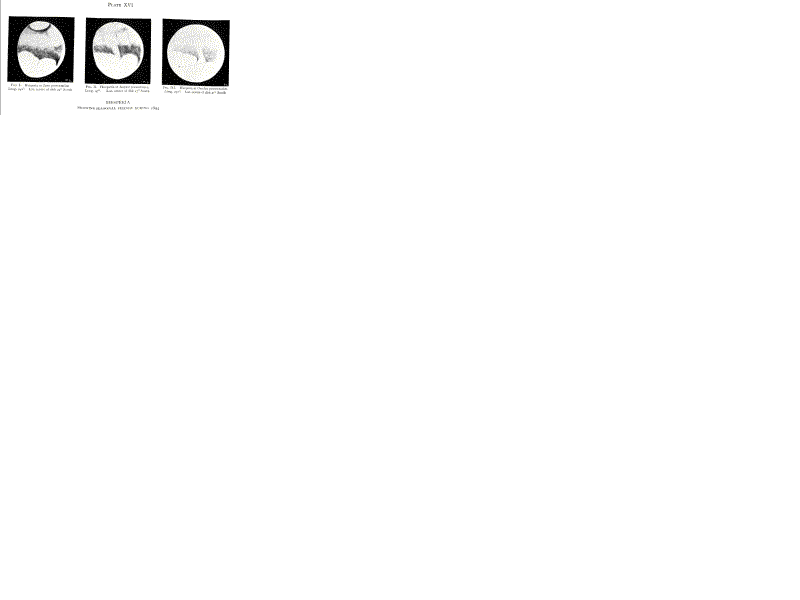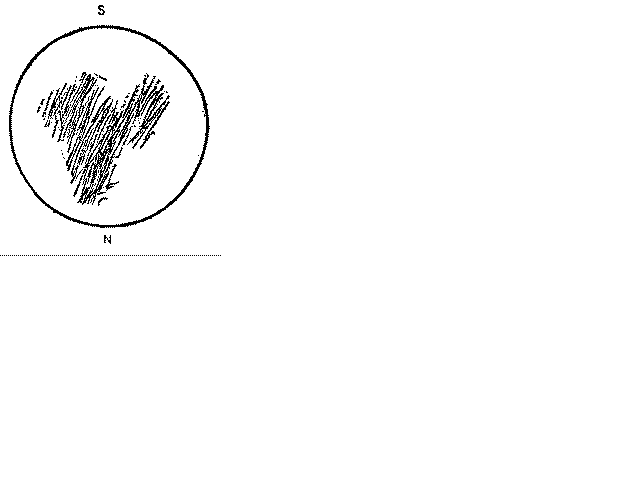he revolved about the Sun outside of the Earth. A glance at the diagram of the orbit will make the latter
point clearer. If we draw a line from the Sun to the centre of Mars and pass a plane through the planet
perpendicular to this line and to the plane of his orbit, this plane will divide the illumined half of him from
the unillumined half. If now we draw another line from any point of the Earth's orbit to Mars' centre, and
pass a plane similarly perpendicular to that, it will cut off the hemisphere we see at any moment from
the one we do not. As the two lines do not in general coincide, it will appear that in certain positions, in
fact in all but two, Mars must present to us a face partly steeped in daylight, partly shrouded in night; in
short, that he shows gibbous like the Moon when she is between the half and the full. This accounts
for the look of the drawings made during June, 1894, in which from a seventh to a sixth of the disk is
wanting on the left.
See Plates 15 16
16 17
17
By drawing lines from his centre to more than one position occupied by the Earth it will be seen that this lacking lune reaches a maximum when the Earth as viewed from Mars is at extreme elongation from the Sun, and that the amount of the phase at such time exactly equals the number of degrees of this elongation. For example, on the sixteenth of last June the lacking lune amounted to 47 degrees, that is, the Earth was then evening star upon the Martian twilight skies at an angular distance of 47 degrees from the Sun, about what Venus seems to us at her extreme elongation. In fact, to Mars we occupy much the same astronomical position that Venus does to us.
To Huyghens we owe the first really important telescopic observation upon the planet. On November 28, 1659, at 7 P.M., he made the first drawing of the planet worthy the name, for on it is the first identifiable feature ever made out by man on the surface of Mars. This feature is the Hourglass Sea, now more commonly known as the Syrtis Major. The accompanying cut of it is reproduced from Flammarion.
 Huyghens' drawing of the Syrtis Major, Nov. 28, 1659 7 P. M. Reproduced from Flammarion's "La Planete
Mars."
Huyghens' drawing of the Syrtis Major, Nov. 28, 1659 7 P. M. Reproduced from Flammarion's "La Planete
Mars."
If the dark patch in it be compared with the markings in the other pictures of the planet, shown later in this book, it will be seen that the patch can be none other than the Hourglass Sea.
Now, innocent as it looks of much detail, Huyghens' drawing is perhaps the most important one of Mars that has ever been made. For, from his observations of the spot it depicts at successive dates, he was able to prove that Mars rotated on his own axis, and to determine the time of that rotation, about 24 hours. As he subsequently came to doubt his results, the honor of the discovery rests with Cassini, who, in 1666, definitely determined that the planet rotated in 24 hours 40 minutes. Thus was it first learned that Mars had a day, and that its length was not far from the length of our own.
The importance of these earliest pictures of Mars has not lapsed with the lapse of time. By comparison of this and other early drawings with modern ones, has been deduced a very accurate value of the length of the Martian day (its sidereal day), a determination accurate to the tenth of a second. It amounts to 24 hours, 37 minutes, 22.7 seconds. Our sidereal day, that is, the day reckoned by the stars, not by the Sun, is roughly 23 hours, 56 minutes; so that the Martian day is about 40 minutes longer than our own. The result is not given here closer than the tenth of a second, because the Flagstaff observations have shown that the value of the length of the Martian day hitherto accepted is probably a trifle too small.
From the discovery of the rotation followed the approximate position of the planet's poles. Round about the poles so determined appeared two white patches, the first study of which we owe to Maraldi. They are the planet's polar caps. They are to be detected with the smallest modern telescope.
The apparent position of the planet poles as presented to the Earth gives the tilt of the planet's axis to the plane of its orbit. It turns out to be about 25 degrees. This is very nearly the same as the Earth's axial tilt to the plane of her orbit, which is 23 degrees 24'. As the inclination of the axis to the plane of the orbit determines the seasons, we see that not only has Mars its spring, summer, autumn, and winter, but that these are not very unlike our own.
| Previous chapter/page | Back | Home | Email this | Search | Discuss | Bookmark | Next chapter/page |